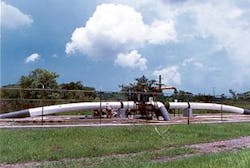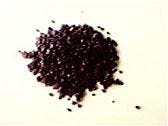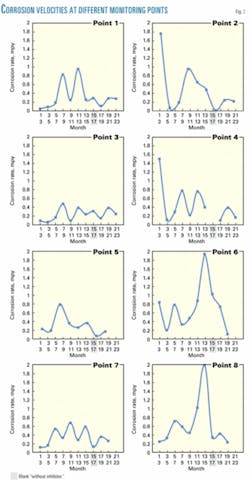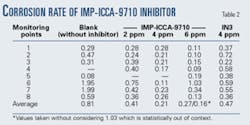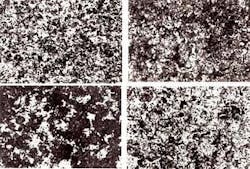J.L. Benítez A., G. Guzmán P. & L. Muñoz P., Instituto Mexicano del Petróleo, Mexico City
C. Sánchez M., Petróleos Mexicanos, Mexico City
Pemex Refinación, part of Petróleos Mexicanos (Pemex) and operator of more than 4,100 km of crude oil pipelines in several diameters, has tested a newly developed corrosion inhibitor on 30, 24, and 20-in. OD pipelines on a 220-km extension. The inhibitor, IMP-ICCA-9710, is manufactured and marketed by Pemex.
During the evaluation period, a 100% increase in crude salt content was also observed at the end of the evaluation line.
The intermingling of additional streams feeding the test section caused this increase.
Additionally, analysis of some deposits revealed a content of 4% organic material and 96% inorganic compounds.
Evaluation of the corrosion inhibitor additive showed a reduction in corrosion velocity, compared over the same period of time with no inhibitor.
Increasing the corrosion inhibitor's concentration further decreased corrosion velocity.
At 4-ppm concentration, IMP-ICCA-9710 proved to be 1.7 times more efficient than IN-3 inhibitor, another product manufactured and marketed by Pemex, which was in use at the time of the tests.
The protecting film formed by the new inhibitor, when analyzed under a microscope (100X), was more resistant than that formed by IN-3, for which pitting was detected as well as a surface damaged by corrosion.
Corrosion velocities reported during IMP-ICCA-9710 application have a constantly decreasing tendency, even though no excessive sudden decrease was observed.
Background
An earlier study compared the new inhibitor IMP-ICCA-9710 for crude pipelines with other commercial inhibitors available in market (OGJ, June 17, 2002, p. 66).
Laboratory tests were performed simultaneously for rust,1 electrical resistance,2 bottle test,3 and dynamic circuit (loop).4 Being hydrocarbon soluble, this new inhibitor provided a high protection efficiency against crude oil corrosive agents.
The national transportation pipeline system of Pemex consists of more than 12,000 km, of which 4,103 km are crude oil with diameters between 12 and 48 in.
This corresponds to 9.3 million crude bbl in the pipeline system.
With other operators around the world, Pemex is processing more heavy crudes in response to increasing demand.
These factors require focusing on internal corrosion control for crude pipelines. In the past, IN-3 corrosion inhibitor provided a satisfactory protection. The new inhibitor shows superior results in laboratory tests and was worth considering for testing at field level.
Therefore, Pemex agreed to carry out an evaluation on crude pipelines with diameters from 20 to 32 in. and on a 220-km extension.
Work
On the chosen section, eight sampling and monitoring points were identified (Fig. 1).
On this segment, crude oil from other streams enters the line at KP 31 and 76.
First of all, operators stopped injecting IN-3 inhibitor for a 10-week period and, on the second week, ran scrapper pigs to clean the pipeline interior.
After deep cleaning, all corrosion coupons were removed from the monitoring points and new ones were installed at these points; this procedure was usually performed at middle of the month.
Crude oil samples were taken from Sampling Points 1 and 8 and analyzed to evaluate the effect of incorporating other crude oil streams into the testing of the pipeline.
Table 1 shows these crude oil characterizations. Most properties remain the same, except for salt content, especially on Testing Point 8 where salt content doubled.
Fig. 2a showing pipeline throughput reveals that transported volume is not constant.
This means that inhibitor dosing requires careful control. Even with variations in transported crude barrels as well as in inhibitor consumption, product dosing was carefully controlled to maintain an acceptable corrosion inhibitor concentration (Fig. 2b).
Because the corrosion coupons placed on the pipelines are aboveground, it is difficult to observe corrosion in stratified streams (Fig. 3), but a generalized corrosion within annular flow section can be observed.
When coupons were removed for evaluation, some deposits appeared at certain points, making handling difficult. In other cases, the coupons were not found, as at Monitoring Point 4 (during months 15 to 17).
This was considered a reference period (without inhibitor) and also happened on Monitoring Point 5 (during months 9-23).
The cleaning procedure could have caused the loss of the coupons and led, therefore, to an adjustment in the coupons' heights.
In some monitoring points, removing coupons was made difficult by deposits. In these cases, samples of the deposits were taken and analyzed (Fig. 4).
The deposits show an average particle size of 2 mm, part being soluble in organic solvents. The fraction extracted with hexane represented 4%.
The remaining 96% was identified with X-ray diffraction and fluorescence techniques, such compounds as Fe, S, Ca and Si:
Fe3O4, iron oxide (magnetite)
FeO(OH), hydroxide iron oxide (goethite)
σ-SiO2, silica oxide (alpha quartz)
CaCO3, calcium carbonate (calcite)
Probable:
FeS, iron sulfide (troilite)
From first month to month 15, IN-3 corrosion inhibitor was dosed at 3.8 ppm average over the entire system.
The corrosion rate during this period varied from 0.05 to 1.99 mils/year (mpy), with an average 0.46 mpy. This crude pipeline exhibited a low corrosion rate, but the newly developed inhibitor IMP-ICCA-9710 rendered several additional advantages.
The corrosion rates in reference line during the period without any inhibitor were less than 1.0 mpy, in five out of eight monitoring points.
At Monitoring Point 4, the coupon was absent, and in Monitoring Points 6 and 8, the corrosion rate increased to 1.95 and 1.99 mpy, respectively.
Fig. 5 shows some graphs representing corrosion rates at selected evaluation points.
As the inhibitor concentration increases, corrosion velocity decreases (Table 2).
Considering average corrosion rates from the eight evaluation points in relation to reference line (without inhibitor), a percent protection against corrosion was calculated with 2, 4 and 6 ppm IMP-ICCA-9710 and with 4 ppm IN-3 inhibitor.
Table 3 shows complete results.
Calculating protection efficiency against corrosion is as follows:
Efficiency against corrosion, % = ([VLR - VE]/ VLR) x 100
where:
VLR = Corrosion rate in reference line.
VE = Corrosion rate at monitoring point to be evaluated.
In a detailed analysis of the coupons' surfaces. microphotographs (100X) were taken after the coupons had been cleaned and weighed (Fig. 6).
Further analysis was then conducted on a clean coupon (unused), one tested without inhibitor, one tested with IN-3 inhibitor, and one tested with IMP-ICCA-9710 inhibitor.
A detailed analysis was performed on Monitoring Point 6.
Results
Only slight changes in crude oil properties appeared between the beginning and end of the evaluated pipeline, and these were due to incorporation of crude oil from external streams, between KP 31 and 76.
API gravity increased at the end of pipeline in 1.04 units, as reflected in the salt content increase from 13.0 to 22 lb/1,000 bbl. Sulfur percent and acidity, however, did not change (Table 1).
Results from analyzed deposits show that this material is mainly inorganic (96%), containing corrosion products (Fe3O4, FeO(OH) and FeS) and salts CaCO3 which were also identified.
Only 4% of analyzed deposits were organic, and infrared analysis of the samples identified a mixture of saturated hydrocarbons, as well as aromatics. The organic compounds included inorganic matter.
These deposits have a certain degree of hardness, which means that operations under high pressure and flow conditions may erode the interior of the pipelines.
Evaluation of IN-3 inhibitor showed an average corrosion rate of about 0.46 mpy with 3.8-ppm average dose (Fig. 2).
These values fall within pipeline operation specifications.
With IMP-ICCA-9710 inhibitor, however, these values improved, both at the laboratory level and during the field test.
As Fig. 5 shows, only Monitoring Points 6 and 8 are affected when no inhibitor is dosed, while the other monitoring points remain constant.
During the IN-3 application, changes in corrosion rate appeared, reaching values up to 1.5 mpy, while during IMP-ICCA-9710 application, a higher protection appeared with values remaining at less than 1.1 mpy and a tendency to lower corrosion-rate values appeared.
IMP-ICCA-9710 dosing at 2, 4, and 6 ppm gives more protection against corrosion than with IN-3 inhibitor at 4 ppm. (An exception was observed at Monitoring Point 6, with 2 ppm.)
If average corrosion rates are considered and percent efficiency at 4 ppm for both inhibitors is calculated (in relation to reference line), it can be concluded that the IMP-ICCA-9710 inhibitor is 1.7 times more efficient than IN-3 inhibitor; this means 74% vs. 42% (Table 3).
Comparing the inhibitors' performances at 4 ppm dosing (IN-3 vs IMP-ICCA-9710) reveals that on all evaluation points (except Nipple 5 where no coupon was found) a reduction in corrosion rate occurred from no less than 3.4% and up to 94.4%.
It was also observed that increasing IMP-ICCA-9710 dosing yielded a reduction in corrosion rate, in all cases.
Microphotographs of the coupons revealed that coupons without inhibitor protection (blank) as well as coupons with IN-3 inhibitor were completely corroded (more than 50% surface), while a coupon with IMP-ICCA-9710 show a surface less affected by corrosive agents (percentages were obtained comparing with clean coupon).
This means that a resistant film is formed on the surface, providing good protection for pipelines with this inhibitor. A more-resistant film is formed with IMP-ICCA-9710, better than with IN-3; this means savings and an efficient protection to crude pipelines for Pemex-Refinación.
References
- NACE Standard TM-0172, "Test Method Antirust Properties of Petroleum Products Pipeline Cargoes."
- ASTM G 3-89, "A Standard Practice for Conventions Applicable to Electrochemical Measurements in Corrosion Testing."
- NACE ID182,"Wheel Test Method Used for Evaluation of Film Persistent Inhibitors for Oilfield Applications."
- Eaton, Paul, and Sutton, Greg, "The effect of flow on inhibitor film life," NACE Corrosion94, Paper 30.
The authors
José Luis Benitez Aguilar (jbenitez @imp.mx) is a researcher in the corrosion technology group at the Instituto Mexicano del Petróleo. Benitez holds a PhD in chemistry from Universidad Autónoma Metropolitana (México) and is a member of the Researchers National System.
Carlos Arturo Sánchez Magaña is a consultant and manager in corrosion control for Pemex Refinación and a specialist in anticorrosive treatments for Pemex pipeline systems.
Guadalupe Guzmán Pruneda has been a researcher at the Instituto Mexicano del Petróleo since 1978. She holds a chemistry degree (1967) from the Universidad Nacional Autónoma de México (UNAM).
Lourdes Muñoz Pardiñas is a specialist in technical services in petroleum plants and has worked in research staffs in developing corrosion inhibitors, demulsifiers, antifouling, antirust additives, and water treatment products. She graduated from La Salle University, Mexico, in 1985.




